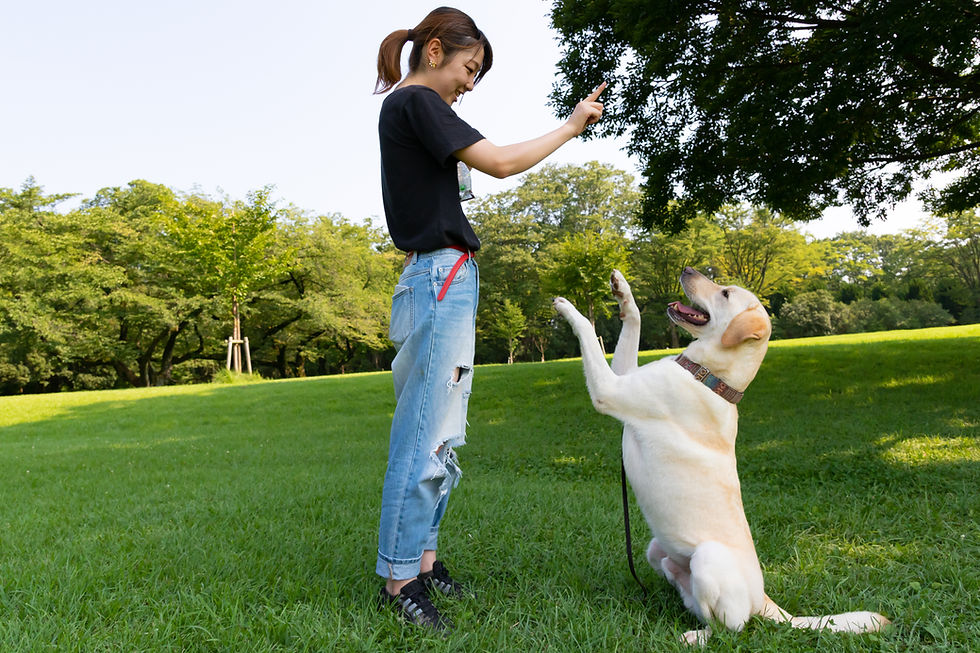What are the basic commands every dog should learn?
- Subhodip Unitel
- Sep 25, 2024
- 4 min read
Training your dog is one of the most rewarding experiences you can have as a pet owner. It strengthens your bond while ensuring your dog is well-behaved and safe. If you’re looking for effective dog training in North London, understanding the basic commands is essential. Here’s a guide to the fundamental commands every dog should master, along with tips to help you along the way.

1. Sit
The "sit" command is often the first command taught to dogs. It’s simple and effective. To teach your dog this command:
Start with a Treat: Hold a treat close to your dog's nose.
Move Your Hand Up: Allow their head to follow the treat, causing their bottom to lower.
Say "Sit": As soon as they sit, say "sit" and give them the treat.
This command is beneficial for keeping your dog calm in various situations, especially during greetings.
2. Stay
Once your dog has mastered "sit," the next step is "stay." This command helps keep your dog in place, promoting safety.
Command and Reward: Start in a sitting position. Say "stay" and take a step back.
Return and Reward: If your dog stays, return and reward them. Gradually increase the distance and duration.
Using the "stay" command can prevent your dog from running off in busy areas, making it crucial for safety during walks.
3. Come
The "come" command is vital for ensuring your dog returns to you when called. This command can be lifesaving in various situations.
Use a Leash: Start in a safe, enclosed area. Use a leash for control.
Call Your Dog: Say "come" while gently pulling on the leash.
Reward Immediately: When they come to you, reward them with praise and a treat.
This command fosters trust and encourages your dog to respond quickly.
4. Down
Teaching your dog to "down" is beneficial for control, especially in social situations.
Use a Treat: Begin with your dog in a sitting position. Hold a treat close to their nose.
Move Downward: Lower the treat to the ground. Your dog will follow it down.
Say "Down": As soon as they lie down, say "down" and give them the treat.
The "down" command helps in keeping your dog calm and relaxed, especially during gatherings.
5. Leave It
The "leave it" command is crucial for keeping your dog safe from harmful items or distractions.
Hold a Treat in Your Hand: Let your dog sniff it but don’t let them have it.
Say "Leave It": Use the command while closing your hand.
Reward for Ignoring: If your dog ignores the treat, reward them with a different treat.
This command helps prevent your dog from picking up dangerous objects or engaging in unwanted behaviours.
6. Heel
The "heel" command teaches your dog to walk beside you without pulling on the leash. It’s particularly useful during walks.
Use a Leash: Start with your dog on a leash.
Say "Heel": Walk forward, and say "heel" while encouraging them to stay close.
Reward for Good Behaviour: If your dog stays by your side, reward them frequently.
This command creates a more enjoyable walking experience for both of you.
7. Off
The "off" command helps manage jumping or unwanted behaviours. It’s essential for training your dog to respect personal space.
Use a Firm Voice: When your dog jumps up, calmly say "off."
Guide Them Down: Gently push them down if necessary.
Reward for Correct Behaviour: When they are on the ground, reward them with praise.
This command helps establish boundaries and promotes good manners.
8. No
The "no" command is straightforward but important. It helps communicate unacceptable behaviour.
Use a Firm Tone: When your dog engages in undesired behaviour, firmly say "no."
Redirect Their Attention: Immediately redirect them to an appropriate behaviour or command.
Reward for Compliance: When they obey, reward them with a treat.
Using this command consistently will help your dog understand limits.
9. Wait
The "wait" command teaches patience and is particularly useful at doorways or during meal times.
Start in a Sitting Position: With your dog sitting, open the door slightly.
Say "Wait": Give the command and close the door if they move.
Reward for Good Behaviour: When they stay in place, reward them.
This command is essential for safety, ensuring your dog does not bolt out the door.
10. Crate Training Commands
If you use a crate, teaching commands related to it is beneficial. Use commands like "kennel" or "go to bed" to encourage your dog to enter their crate.
Use Treats: When you say the command, toss a treat inside.
Encourage Entry: Repeat the command until your dog associates it with entering the crate.
Reward for Compliance: Once inside, give them a treat.
This command helps create a positive association with their crate, making it a safe space.
Conclusion
In conclusion, mastering these basic commands is essential for effective dog training in North London. These commands not only enhance your dog's behaviour but also strengthen your bond. For expert guidance, consider working with a North London dog trainer. With Doggle by your side, you can ensure that your furry friend becomes a well-mannered companion, ready to tackle any challenge together.



Comments